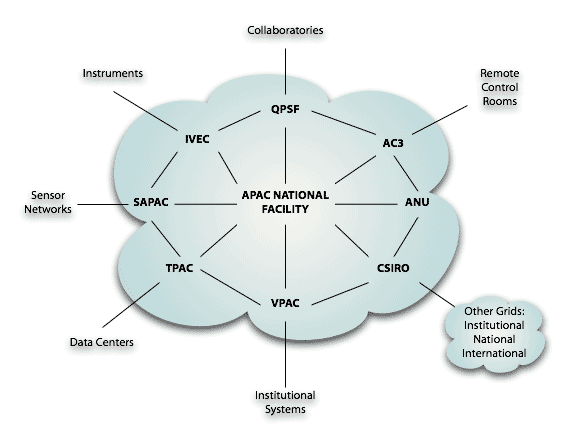The aim of the APAC National Grid is to allow research teams to easily access the resources at the National Facility and the partner facilities as a single virtual system. These resources include
- A variety of computing systems with a diverse range of applications software
- Large-scale data storage systems providing services for information management and access
- Portals and associated services to access the resources
- Collaborative work environments including access grid rooms at each partner site and a range of visualisation and virtual reality facilities.
The APAC National Grid therefore provides a variety of resources to support distributed research teams in an operational (or ‘production level’ environment).
The design of the National Grid incorporates open interfaces to other resources such as institutional computing systems, on-line instruments, sensors and other data sources. It is also developing interfaces that will allow inter-operation with other grids at the institutional, national and international levels. The design aims to allow researchers to see the resources in the APAC National Grid as an extension of their personal work environments. In this sense, the National Grid is an infrastructure that is transparent to most of its users.
The concept of the National Grid as an integrated virtual system with interfaces to external systems and grids as illustrated in Figure 1 below. The resources of the APAC National Facility and the partner facilities are included in the cloud, unified through a common security system and portals to access the resources.

Most of the users of the National Grid will be the current users of the individual systems. The National Grid offers them an easier way to access multiple resources provided by APAC and its partners. As a result, the extent of the resources in the National Grid is being determined by those users that want to access resources through the National Grid interface mechanisms (portals, authentication, authorization). This approach avoids the need for partners to pre-determine a percentage of the resources to be allocated to users of the National Grid. In addition, the current processes to determine the resources provided to users can be continued.
The policies and agreements between the partners to support this approach are based on existing agreements that have been developed elsewhere for production grids. More effort is required to determine the agreements for external organizations in order to interface their systems to the National Grid. This will require an understanding of the services that these organizations demand from the National Grid.






